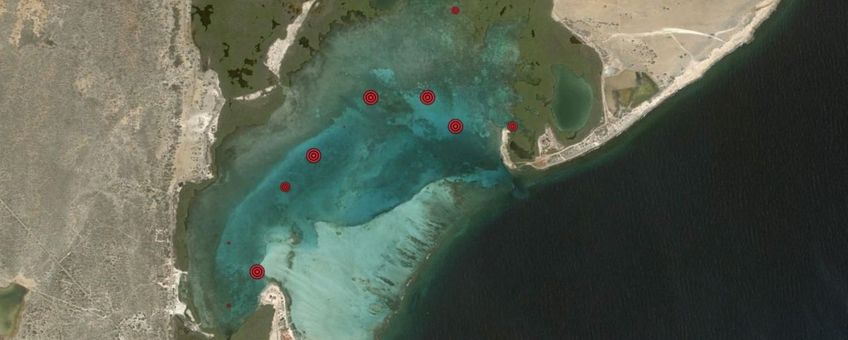
Invasieve zeegrassoort verovert Lac Bay, Bonaire
Bericht uitgegeven door Dutch Caribbean Nature Alliance (DCNA) [land] op [publicatiedatum]
Lac Bay op Bonaire staat bekend om zijn unieke habitats met zeegrasvelden. Zeegrasvelden zijn erg belangrijk voor het ecosysteem van Lac Bay: zeeschildpadden, schelpdieren en andere dieren zoeken er voedsel, en verschillende vissoorten gebruiken ze als broedplaats. Bovendien spelen ze een rol in de kustbescherming en in het terugdringen van het aantal broeikasgassen. In 2010 werd er een nieuwe zeegrassoort ontdekt, Halophila stipulacea, een invasieve soort afkomstig uit de Rode zee en de Persische golf, die sinds 2003 oprukt in het Caribisch gebied. Tussen 2010 en 2013 is het aandeel H. stipulacea in Lac Bay gemiddeld toegenomen van 6 tot 14 procent ten koste van de inheemse soorten. De komende tijd wordt de ontwikkeling van deze nieuwe zeegrassoort en zijn effect op de rest van het ecosysteem verder onderzocht.
Lac Bay, Bonaire, is well known for its unique habitats that contain seagrass beds across the entire shallow bay and dense mangrove forests further inland. The seagrass beds form a vital part of the ecosystem of Lac Bay, serving as foraging ground for sea turtles, conch and other animals, nursery ground for various fish species, and beach protection as a ‘sediment sink’, keeping sand in place. They even help with the reduction of greenhouse gases, something that is often failed to mention.

For the Queen Conch (Lobatus gigas), one of Bonaire’s flagship conservation species, the sea- grass beds of Lac Bay form their most important food source. The conch do not eat the actual leaves of the seagrass, but the epiphytes growing on it and the dead organic material. There is a direct correlation between the biomass of the Turtle Grass (Thalassia testudinum) and the abundance of the Queen Conch.
As early as 1969, Wagenaar Hummelinck and Roos mention the occurrence of four native species of seagrass in Lac Bay: Thalassia testudinum, Syringodium filiforme, Diplanthera wrightii (actual name: Halodule wrightii) and Ruppia maritima. Their study brought forth a rough distribution map. Moorsel and Meijer performed a baseline study of Lac in 1993 and found that H. wrightii was no longer present. However, monitoring efforts for STINAPA Bonaire by Cindy Lott in 1999, and also by Sabine Engel in 2007, showed that this was not the case and H. wrightii has not gone extinct within the confounds of the shallow water bay.
Under the banner of the Conch Restoration Project, seagrass monitoring in Lac Bay was continued in 2010, and immediately the presence of a new species, Halophila stipulacea, was noted. This invasive alien species originates from the Red Sea and Persian Gulf, and was first discovered in the Caribbean region in 2003 near Grenada. From that moment it has rapidly expanded its distribution and is now found throughout the entire Caribbean region.
Every new introduction of an invasive alien species warrants close monitoring, and in this case, given the local importance of the Queen Conch, even more so. Questions are raised as to what this new invasive species will mean for Lac Bay and Bonaire as a whole. Will sea turtles and conch forage on its beds, and will it eventually outcompete the other seagrasses?
Monitoring efforts estimated the cover of the five species of seagrass by counting their presence in 46 permanent quadrats evenly spread over the entire area of Lac Bay. The initial survey in 2010 showed a mean cover of H. stipulacea at almost 6% and the latest survey in 2013 showed a dramatic increase to over 14%, which coincided with a general decrease of all native seagrass species. R. maritima prefers more hypersaline waters, so it is only found at the outer borders of Lac Bay, an area not covered in both surveys.

Literature shows that one of the reasons H. stipulacea manages to take over new territory so fast is anchoring, however, this cannot be the case in Lac Bay, where anchoring is forbidden. Lac Bay is not the only place on Bonaire where the invasive seagrass is observed. It has also been found in Lagoen and at the entrance of Pekelmeer, which is a restricted Ramsar site, so anchoring here is out of the question, and right outside Lac on the reef at a depth of 10 metres. So far it has not been reported off the west coast of Bonaire.
During the surveys there was a lot of floating plant debris found in the water column, such as algae and (parts of) several seagrass species. The difference between the floating material of H. stipulacea and the native species is that where the other species mostly show detached leaves, parts of the leaves or rhizomes (i.e. the connecting subterranean roots), the invasive H. stipulacea shows complete plants with leaves, stems and rhizomes all attached.
Although the Conch Restoration Project is coming to an end, the interest in and concern for H. stipulacea will not. Monitoring efforts will continue with the support of STINAPA, starting with Tineke van Bussel, intern at the Sea Turtle Conservation Bonaire, who will be looking into seagrass productivity and competition in Lac Bay.
Text: Sabine Engel
Figures: Google Earth Pro - DigitalGlobe; DCNA
Bron: BioNews June/July 2013 edition, DCNA
Nederlandse inleiding: Sara Mulder, De Natuurkalender
